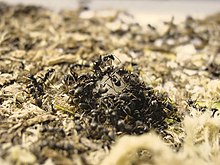Gray-black slave ant
| Gray-black slave ant | ||||||||||
|---|---|---|---|---|---|---|---|---|---|---|

Gray-black slave ant ( Formica fusca ) |
||||||||||
| Systematics | ||||||||||
|
||||||||||
| Scientific name | ||||||||||
| Formica fusca | ||||||||||
| Linnaeus , 1758 |
The gray-black slave ant ( Formica fusca ) from the subfamily of the scale ants (Formicinae) belongs to the genus of forest ants ( Formica ) and there to the subgenus of slave ants ( Serviformica ).
features
It is black and shiny all over the body and covered with short hairs. The workers reach a size of 4.5 to 7.5 millimeters, while sex animals can be up to 11 millimeters in size. They swarm between late June and early September.
distribution and habitat
It builds its nests mainly in the ground; Open and moderately shaded places are preferred. It loves warmth and avoids the interior of shady forests. The distribution area extends over the west of the Palearctic . In Fennoscandia the habitat extends up to 65 degrees north latitude. The gray-black slave ant is common throughout Central Europe. In the Alps it occurs at altitudes of up to 1,800 meters. At higher altitudes it is replaced by Formica lemani , which occurs up to 3,000 meters.
Way of life
The nests are mostly polygynous , i. H. several mated queens live in them. The workers can live to be eight years old. The slave ant often falls victim to other species that establish their own colony with the help of the Formica fusca workers. In addition, Formica fusca is regularly attacked by the blood-red predator ant ( Formica sanguinea ) and the Amazon ant ( Polyergus rufescens ), which steal their pupae (hence the name slave ant).
nutrition
The diet consists mainly of insects and honeydew .
Systematics
The species of the gray-black slave ant ( Formica fusca ) is divided into the following subspecies:
- Formica fusca alpicola Gredler, 1858
- Formica fusca fusca Linnaeus, 1758
- Formica fusca fuscolemani Samsinak, 1951
- Formica fusca tombeuri Bondroit, 1917
The fossil Formica flori found in thousands of specimens in the Eocene Baltic amber is so similar to the recent F. fusca that some authors regard it as species-identical, but at least consider the F. fusca as direct descendants of the F. flori .
Individual evidence
- ↑ Bernhard Seifert : The ants of Central and Northern Europe . lutra Verlags- und Vertriebsgesellschaft, Görlitz / Tauer 2007, ISBN 978-3-936412-03-1
- ^ Formica (Serviformica) fusca alpicola Gredler 1858 Fauna Europaea, accessed on May 14, 2007 .
- ^ Formica (Serviformica) fusca fusca Linnaeus 1758 Fauna Europaea, accessed on May 14, 2007 .
- ^ Formica (Serviformica) fusca fuscolemani Samsinak 1951. Fauna Europaea, accessed May 14, 2007 .
- ^ Formica (Serviformica) fusca tombeuri Bondroit 1917 Fauna Europaea, accessed May 14, 2007 .
- ^ Sven Gisle Larsson: Baltic Amber - a Palaeobiological Study. - Entomograph, Vol. 1, Klampenborg (Denmark) 1978.
Web links
- Formica (Serviformica) fusca in Fauna Europaea
